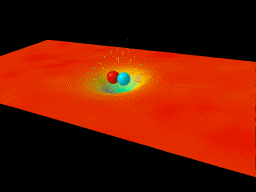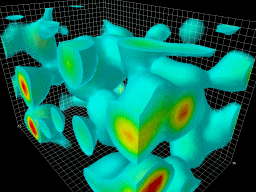DNA of Our Universe
Quantum Fluctuations as Building Mechanism
What is Space and Matter?
The concept of Space and Matter is that we tend to see Space as a vacuum where matter and energy exists but this is incorrect. The nature of Space is formed by Quantum Fluctuations which creates the Virtual Particles that are the "fabric of space". These particles are constantly changing but overall there is an average 'normality' of field density across our Universe which also determines the speed of light and other EM waves. These particle fields are not just local but link the whole of our Universe together like a gravitational and quantum field web where every interaction affects the whole web of a Universe. The mechanics of this interaction has also been shown using quantum mechanics which describes how the cosmos works on the tiniest of scales. Specifically, scientists are studying a bizarre phenomenon of quantum mechanics called "entanglement," where one particle can instantly influence another — even from opposite sides of the Universe.
Physicists (2016) have now confirmed that matter is also no more than fluctuations in the quantum vacuum. The researchers simulated the frantic activity that goes on inside protons and neutrons. These particles provide almost all the mass of ordinary matter. Each proton (or neutron) is made of three quarks – but the individual masses of these quarks only add up to about 1% of the proton’s mass. So what accounts for the rest of it? Theory says it is created by the force that binds quarks together, called the strong nuclear force. In quantum terms, the strong force is carried by a field of virtual particles called gluons, randomly popping into existence and disappearing again. The energy of these vacuum fluctuations has to be included in the total mass of the proton and neutron.
Virtual particles exist for a short time. They do not observe conservation of energy. Heisenberg uncertainity principle applies here. A better way to say it would be to say that all matter is created from ENERGY. Therefore, you can think of "solid" matter (things with mass) as being built with elementary particles, that are made up of quarks, that are made up of energy.

The binding tube of force (gluons) holding the Quarks remains constant
regardless of distance but energy (hence mass) is required to build that tube.
Gluons are massless, but there is so much energy in the field that by E=mc^2 there is a significant amount of mass there, i.e. m=E/c^2. This is where most of the proton's mass (hence your mass) comes from and the mass of virtually everything around you. See the video below for a graphical description:
https://www.youtube.com/watch?time_continue=148&v=Ztc6QPNUqls&feature=emb_logo
Vacuum energy is an underlying background energy that exists in Space throughout the entire Universe. One contribution to the vacuum energy may be from virtual particles which are thought to be particle pairs that blink into existence and then annihilate in a minute timespan. They are expected to do this everywhere, throughout the Universe. The effects of vacuum energy can be experimentally observed in various phenomena such as spontaneous emission, the Casimir effect and the Lamb shift, and are thought to influence the behavior of the Universe on cosmological scales. In quantum field theory, the Casimir effect, also known as the Casimir force, is a physical force acting on the macroscopic boundaries of a confined space which arises from the quantum fluctuations of the field. A collaboration between researchers from the University of Western Australia and the University of California Merced has provided a new way to measure tiny forces and use them to control objects. https://phys.org/news/2020-08-casimir.html
Some more related explanations here at: http://science.jrank.org/pages/7195/Virtual-Particles.html
Physicists have developed a method called lattice Quantum Chromodynamics (QCD) that allows the complexities of the strong force to be simulated approximately by computer (thanks to Prof. Leinweber). The animation below is of the most recent visualizations of Quantum Chromodynamics, the underlying theory of the strong interactions. As a key component of the Standard Model of the Universe, QCD describes the interactions between quarks and gluons as they compose particles such as the proton or neutron. Quarks are the basic elements that build matter, while Gluons are elementary particles that act as the exchange particles for the strong force (hence 'glue') between quarks.


It illustrates the typical four-dimensional structure of gluon-field configurations averaged over in describing the vacuum properties of QCD. The volume of the box is 2.4 by 2.4 by 3.6 fm, big enough to hold a couple of protons. Contrary to the concept of an empty vacuum, QCD induces chromo-electric and chromo-magnetic fields throughout space-time in its lowest energy state. After a few sweeps of smoothing the gluon field a lumpy structure reminiscent of a lava lamp is revealed. The action density (first) and the topological charge density (second) are displayed. The former is similar to an energy density while the latter is a measure of the winding of the gluon field lines in the QCD vacuum. The winding blobs (such as the anti-clockwise yellow blob in the lower animation) seem to be the actions required to build the particles such as quarks and gluons which, in turn, provide building blocks for protons and neutrons, etc. [APE smearing is the smoothing algorithm applied.] Derek B Leinweber. See www.physics.adelaide.edu.au/theory/staff/leinweber/

